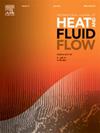钝体三维流体绕流涡识别方法的定量比较
IF 2.6
3区 工程技术
Q2 ENGINEERING, MECHANICAL
International Journal of Heat and Fluid Flow
Pub Date : 2025-02-16
DOI:10.1016/j.ijheatfluidflow.2025.109773
引用次数: 0
摘要
涡旋的识别仍然是流体力学中一个关键但尚未解决的挑战,因为没有普遍接受的涡旋定义存在。本研究比较了几种用于模拟不同雷诺数和攻角下圆柱和长方体周围三维流体流动的涡旋检测方法,包括一个高度湍流的流动情况。研究的方法包括传统的欧拉局部判据——ω判据、q判据和λ2判据,以及最近的方法,如Ω-method、Rortex法、Omega-Liutex法和拉格朗日平均涡度偏差(LAVD)。分类度量和可视化方法用于量化和比较每种方法的性能。虽然传统标准和Rortex方法只有在精心选择的参数下才能显示准确性,但Ω-和Omega-Liutex方法使用接近建议值0.52的阈值,获得了具有一致不确定度的可靠结果。在高度三维湍流中,所有方法都遇到了剪切污染的挑战,尽管LAVD方法是最稳健的。然而,LAVD方法依赖于基于二维平面的分析,限制了其捕捉此类流动中涡的完整体积性质的能力,从而降低了精度。LAVD方法与阈值无关,可以提供准确的结果,但其代价是较高的计算时间。结论是,对于计算资源有限的应用程序,更简单的方法如Ω-method可能是可取的。然而,在需要高精度的场景中,LAVD方法尽管处理时间较长,但可能更有效。本文章由计算机程序翻译,如有差异,请以英文原文为准。

Quantitative comparison of vortex identification methods in three-dimensional fluid flow around bluff bodies
The identification of vortices remains a critical yet unresolved challenge in fluid mechanics, as no universally accepted definition of a vortex exists. This study compares several vortex detection methods applied to the simulation of three-dimensional fluid flows around a cylinder and a rectangular cuboid at various Reynolds numbers and angles of attack, including a highly turbulent flow case. The methods under investigation include traditional Eulerian local criteria – -criterion, -criterion, and -criterion – as well as more recent approaches such as the -method, Rortex method, Omega-Liutex method, and the Lagrangian-averaged vorticity deviation (LAVD). Classification metrics and visualization methods are used to quantify and compare the performance of each method. While traditional criteria and the Rortex method demonstrated accuracy only with carefully chosen parameters, the -, and Omega-Liutex methods achieved reliable results with consistent uncertainty using threshold values near the suggested value of 0.52. In highly three-dimensional turbulent flows, all methods encountered challenges with shear contamination, though the LAVD method was the most robust. However, the LAVD method’s reliance on two-dimensional plane-based analysis limits its ability to capture the full volumetric nature of vortices in such flows, which contributed to reduced accuracy. The LAVD method is threshold independent, and can provide accurate results, however, only on the cost of high computational time. It is concluded that for applications with limited computational resources, simpler methods like the -method may be preferable. However, in scenarios requiring high accuracy, the LAVD method, despite its longer processing time, could be more effective.
求助全文
通过发布文献求助,成功后即可免费获取论文全文。
去求助
来源期刊

International Journal of Heat and Fluid Flow
工程技术-工程:机械
CiteScore
5.00
自引率
7.70%
发文量
131
审稿时长
33 days
期刊介绍:
The International Journal of Heat and Fluid Flow welcomes high-quality original contributions on experimental, computational, and physical aspects of convective heat transfer and fluid dynamics relevant to engineering or the environment, including multiphase and microscale flows.
Papers reporting the application of these disciplines to design and development, with emphasis on new technological fields, are also welcomed. Some of these new fields include microscale electronic and mechanical systems; medical and biological systems; and thermal and flow control in both the internal and external environment.
 求助内容:
求助内容: 应助结果提醒方式:
应助结果提醒方式:


